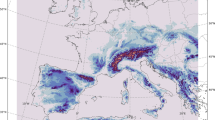Summary
A method for calculation of initial temperature in a coordinate models from pressure gradient force interpolated from constant pressure surfaces is discussed. Uniqueness of the solution is examined. It is demonstrated that there exists a possibility of obtaining two solutions. An approximative procedure for defining unique temperature is proposed. Advantages of the method are demonstrated using several examples. Amongst these, forecasts of a Genoa Gulf cyclogenesis are made with and without application of the proposed technique.
Zusammenfassung
Es wird eine Methode zur Berechnung der Ausgangstemperatur in a Koordinatenmodells aus der aus konstantem Bodendruck interpolierter Druckgradientkraft besprochen. Die Einzigartigkeit der Lösung wird untersucht. Es wird gezeigt, daß es eine Möglichkeit für zwei Lösungen gibt. Ein Näherungsverfahren zur Bestimmung eines einzigen Temperaturwertes wird vorgeschlagen. Vorteile dieser Methode werden an einigen Beispielen gezeigt. Dabei werden Vorhersagen für die Zyklonen im Golf von Genua mit und ohne Anwendung der vorgeschlagenen Methode durchgeführt.
Similar content being viewed by others
References
Arakawa, A.: Design of the UCLA General Circulation Model. Numerical Simulation of Weather and Climate, Dept. of Meteorology, Univ. of California Los Angeles Tech. Rept. 7, 116 pp. (1972).
Corby, G. A., Gilchrist, A., Newson, R. L.: A General Circulation Model of the Atmosphere Suitable for Long Period Integrations. Quart. J. R. Met. Soc.98, 809–832 (1972).
Gahov, D. F.: Kraevie zadaci. Gosud. Izdat., Fiz. Mat. Lit., 520 pp. (1958).
Gary, J. M.: Estimate of Truncation Error in Transformed Coordinate Primitive Equation Atmospheric Models. J. Atmos. Sci.30, 223–233 (1973).
Janjić, Z. I.: Pressure Gradient Force and Advection Scheme Used for Forecasting with Steep and Small Scale Topography. Contrib. Atmos. Phys.50, 186–199 (1977).
Janjić, Z. I.: Forward-Backward Scheme Modified to Prevent Two-Grid-Interval Noise and Its Application in σ Coordinate Models. Contrib. Atmos. Phys. (In press.)
Mesinger, F.: Forward-Backward Scheme, and Its Use in a Limited Area Model. Contrib. Atmos. Phys.50, 200–210 (1977).
Phillips, N. A.: Principles of Large Scale Numerical Weather Prediction. Dynamic Meteorology, pp. 1–96. Dordrecht-Holland: D. Reidel Publishing Co. 1973.
Phillips, N. A.: Application of Arakawa's Energy-Conserving Layer Model to Operational Numerical Weather Prediction. NOAA, National Weather Service, NMC, Office Note 104, 40 pp. (1974).
Sundqvist, H.: On Vertical Interpolation and Truncation in Connexion with Use of Sigma System Models. Atmosphere14, 37–52 (1976).
Author information
Authors and Affiliations
Additional information
With 7 Figures
Rights and permissions
About this article
Cite this article
Mihafović, D.T. Calculation of initial temperature from interpolated pressure gradient force inσ coordinate models. Arch. Met. Geoph. Biocl. A. 30, 239–251 (1981). https://doi.org/10.1007/BF02257846
Received:
Issue Date:
DOI: https://doi.org/10.1007/BF02257846




